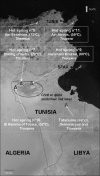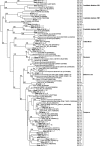Exploration of Deinococcus-Thermus molecular diversity by novel group-specific PCR primers
- PMID: 23996915
- PMCID: PMC3831646
- DOI: 10.1002/mbo3.119
Exploration of Deinococcus-Thermus molecular diversity by novel group-specific PCR primers
Abstract
The deeply branching Deinococcus-Thermus lineage is recognized as one of the most extremophilic phylum of bacteria. In previous studies, the presence of Deinococcus-related bacteria in the hot arid Tunisian desert of Tataouine was demonstrated through combined molecular and culture-based approaches. Similarly, Thermus-related bacteria have been detected in Tunisian geothermal springs. The present work was conducted to explore the molecular diversity within the Deinococcus-Thermus phylum in these extreme environments. A set of specific primers was designed in silico on the basis of 16S rRNA gene sequences, validated for the specific detection of reference strains, and used for the polymerase chain reaction (PCR) amplification of metagenomic DNA retrieved from the Tataouine desert sand and Tunisian hot spring water samples. These analyses have revealed the presence of previously undescribed Deinococcus-Thermus bacterial sequences within these extreme environments. The primers designed in this study thus represent a powerful tool for the rapid detection of Deinococcus-Thermus in environmental samples and could also be applicable to clarify the biogeography of the Deinococcus-Thermus phylum.
Keywords: Deinococcus-Thermus; group-specific primers; molecular diversity.
© 2013 The Authors. MicrobiologyOpen published by John Wiley & Sons Ltd.
Figures


References
-
- Albuquerque L, Simões C, Nobre MF, Pino NM, Battista JR, Silva MT, et al. Truepera radiovictrix gen. nov., sp. nov., a new radiation resistant species and the proposal of Trueperaceae fam. nov. FEMS Microbiol. Lett. 2005;247:161–169. - PubMed
-
- Asker D, Awad TS, McLandsborough L, Beppu T, Ueda K. Deinococcus depolymerans sp. nov., a gamma- and UV-radiation-resistant bacterium, isolated from a naturally radioactive site. Int. J. Syst. Evol. Microbiol. 2011;61:1448–1453. - PubMed
-
- Auchtung TA, Shyndriayeva G, Cavanaugh CM. 16S rRNA phylogenetic analysis and quantification of Korarchaeota indigenous to the hot springs of Kamchatka, Russia. Extremophiles. 2011;15:105–116. - PubMed
-
- Bjornsdottir SH, Petursdottir SK, Hreggvidsson GO, Skirnisdottir S, Hjorleifsdottir S, Arnfinnsson J, et al. Thermus islandicus sp. nov., a mixotrophic sulfur-oxidizing bacterium isolated from the Torfajokull geothermal area. Int. J. Syst. Evol. Microbiol. 2009;59:2962–2966. - PubMed
Publication types
MeSH terms
Substances
LinkOut - more resources
Full Text Sources
Other Literature Sources
Molecular Biology Databases

